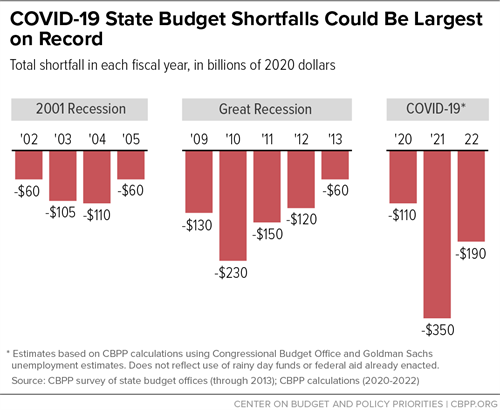It's a key strategy in fight against coronavirus, deep recession
Millions of Americans are facing hardship in the midst of the current public health and economic crisis induced by the novel coronavirus. States are taking action to meet their residents’ health, safety, and financial needs, as well as maintain other essential services that we count on. But states are rapidly approaching budget challenges of their own. Minnesota is no exception – an updated budget projection showed a $2.4 billion shortfall for the current biennium.
The federal funding for state and local governments thus far does not come close to meeting the scale of the need in this moment. Federal policymakers should move quickly to direct significant additional funding to states (as well as local and tribal governments) to address the severe impacts of the public health emergency and the economic recession, and to prevent the economic downturn from getting worse.
The federal government’s role is so important because states are required to balance their budgets. As Minnesotans and folks across the country are staying home to help control the spread of coronavirus, many are also losing income and spending less. That means state and local revenues are dropping at the same time that there’s an increasing number of people needing services to get by. This is why the federal government can and must be a strong partner to state, local, and tribal governments.
What has happened so far: The CARES Act provided funding to state and local governments, as well as tribal nations, of which the $150 billion Coronavirus Relief Fund (CRF) was one the of the largest components. Minnesota state government is expected to receive $1.9 billion from the CRF. Other legislation temporarily increased the federal Medicaid matching rate, as long as states meet certain coronavirus-related coverage requirements. Medicaid is a joint federal-state government responsibility, and this was an important first step in what the federal government needs to be doing to support essential health care services in the states.
But much more is needed. The federal aid allocated so far will be dwarfed by the size of state budget shortfalls – which the Center on Budget and Policy Priorities estimates could total more than $650 billion over three years, with the expected shortfall in 2021 being much larger than seen in any year of the Great Recession. And that’s just the pressure on existing budgets – those numbers don’t include the cost to address the coronavirus.

When they’ve lacked adequate federal support, states have often made decisions that increased hardships for their residents both during and after the recession. The Center on Budget and Policy Priorities has found that decisions in the last recession to lay off teachers and other public employees and reduce funding for other critical services also created a drag on the economy. Many of the challenges that states were wrestling with even before COVID-19 hit had their roots in the cuts made during the last recession, including crumbling infrastructure and higher tuition at public universities.
The federal government should take two important steps to provide additional support to states:
- Further expand the Medicaid matching rate (FMAP) for the duration of the economic downturn, and maintain existing maintenance of effort requirements. Further increasing the FMAP would reach states quickly and protect Medicaid eligibility at a time when health care coverage is crucial; and
- Provide additional flexible funds to states. This could happen by adding funding to the Coronavirus Relief Fund. Federal policymakers should also reverse a counter-productive recent decision from the U.S. Treasury that would severely hamstring state and local governments from using these dollars to fund essential services that were already part of their budgets before the coronavirus hit.
Do you agree with these priorities? Contact your federal representatives today.